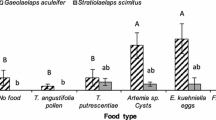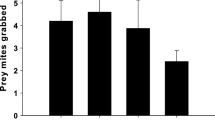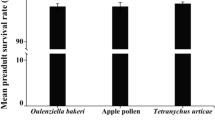Abstract
Phytoseiid mites are commonly used as biological control agents of mite and small insect pests. To facilitate the production of phytoseiids, alternative food sources have been evaluated. The aim of this study was to evaluate the suitability of different food sources for the rearing of the phytoseiids Amblyseius tamatavensis Blommers, Euseius concordis (Chant) and Neoseiulus anonymus (Chant and Baker). This study evaluated the levels of oviposition of these predators when fed with 15 Astigmatina (Sarcoptiformes) mite species, one species of a bacteriophagous nematode, and pollen from five plant species. The highest oviposition rates of A. tamatavensis were obtained when fed on the mites Thyreophagus cracentiseta Barbosa, OConnor & Moraes and Aleuroglyphus ovatus (Troupeau) (2.6 and 2.1 eggs/female/day, respectively). The five highest oviposition levels of E. concordis occurred when the food source was pollen, especially of Ricinus communis L. (1.7 eggs/female/day). The evaluated oviposition levels of N. anonymus were at most 0.5 eggs/female/day on all food sources. The construction of life tables of A. tamatavensis and E. concordis with the two most favorable food sources showed that in both cases the values of rm were higher when the predator was fed with T. cracentiseta and R. communis, respectively. The possible use of pollen of Elaeis guineensis L. should be further evaluated, given the acceptance of this type of pollen by E. concordis and the ease of obtaining large amounts of this pollen in areas where this crop is grown.
Similar content being viewed by others
References
Adar E, Inbar M, Gal S, Doron N, Zhang ZQ, Palevsky E (2012) Plant-feeding and non-plant feeding phytoseiids: differences in behavior and cheliceral morphology. Exp Appl Acarol 58:341–357
Argov Y, Berkeley M, Domeratzky S, Melamed E, Weintraub P, Palevsky E (2006) Identification of pollens for small mass rearing of Neoseiulus californicus and a novel method for quality control. IOBC WPRS Bull 29:127–132
Barbosa MFC, Moraes GJ (2015) Evaluation of astigmatid mites as factitious food for rearing four predaceous phytoseiid mites (Acari: Astigmatina; Phytoseiidae). Biol Control 91:22–26
Brown JK, Frohlich DR, Rosell RC (1995) The sweetpotato or silverleaf whiteflies: biotypes of Bemisia tabaci or a species complex? Annu Rev Entomol 40:511–534
Burnett T (1960) A technique for maintaining acarine predator-prey populations. Can Entomol 92:234–237
Castilho RC, Duarte VS, Moraes GJ, Westrum K, Trandem N, Rocha LCD, Delalibera I Jr, Klingen I (2015) Two-spotted spider mite and its natural enemies on strawberry grown as protected and unprotected crops in Norway and Brazil. Exp Appl Acarol 66:509–528
Cavalcante ACC, Santos VLV, Rossi LC, Moraes GJ (2015) Potential of five Brazilian populations of Phytoseiidae (Acari) for the biological control of Bemisia tabaci (Insecta: Hemiptera). J Econ Entomol 108:29–33
Chant DA (1959) Phytoseiid mites (Acarina: Phytoseiidae). Part I. Bionomics of seven species in southeastern England. Part II. A taxonomic review of the family Phytoseiidae, with descriptions of 38 new species. Can Entomol 91(12):1–166
Chi H (1988) Life table analysis incorporating both sexes and variable development rates among individuals. Environ Entomol 17:26–34
Chi H (2008) TWOSEX-MSCHART. A computer program for age stage, two-sex life table analysis. http://140.120.197.173/Ecology/
Chi H, Liu H (1985) Two new methods for the study of insect population ecology. Bull Inst Zool Acad Sin 24:225–240
Cunha RNV, Lopes R, Dantas JCR, Rocha RNC (2007) Procedimentos para produção de sementes comerciais de dendezeiro na Embrapa Amazônia Ocidental. Embrapa Amazônia Ocidental, Manaus, p 40
De Barro PJ, Liu SS, Boykin LM, Dinsdale AB (2011) Bemisia tabaci: a statement of species status. Annu Rev Entomol 56:1–19
Demite PR, Moraes GJ, McMurtry JA, Denmark HA, Castilho RC (2014) Phytoseiidae database. http://www.lea.usp.br/phytoseiidae/
Ferla JN, Moraes GJ (2003) Oviposição dos ácaros predadores Agistemus floridanus Gonzalez, Euseius concordis (Chant) e Neoseiulus anonymus (Chanr & Baker) (Acari) em resposta a diferentes tipos de alimento. Rev Bras Zool 20:153–155
Flechtmann CHW, McMurtry JA (1992) Studies of cheliceral and deutosternal morphology of some Phytoseiidae (Acari: Mesostigmata) by scanning electron microscopy. Int J Acarol 18:163–169
Gerson U, Smiley RL, Ochoa R (2003) Mites (Acari) for pest control. Blackwell Science, Oxford
Goleva I, Zebitz CPW (2013) Suitability of different pollen as alternative food for the predatory mite Amblyseius swirskii (Acari, Phytoseiidae). Exp Appl Acarol 61:259–283
Huang H, Xu X, Lv J, Li G, Wang E, Gao Y (2013) Impact of proteins and saccharides on mass production of Tyropagus putrescentiae (Acari: Acaridae) and its predator Neoseiulus barkeri (Acari: Phytoseiidae). Biocontrol Sci Technol 23:1231–1244
Kamburov SS (1971) Feeding, development and reproduction of Amblyseius largoensis on various food substances. J Econ Entomol 64:643–648
Lopes PC (2015) Eficiência de populações de Euseius concordis (Acari: Phytoseiidae) e espécies afins no controle do microácaro-do-tomateiro, Aculops lycopersici (Acari: Eriophyidae). Thesis, Escola Superior de Agricultura Luiz de Queiroz, Universidade de São Paulo. http://www.teses.usp.br/teses/disponiveis/11/11146/tde-13052015-163634/
McMurtry JA, Croft BA (1997) Life-styles of phytoseiid mites and their role in biological control. Annu Rev Entomol 42:291–321
McMurtry JA, Scriven GT (1965) Insectary production of phytoseiid mites. J Econ Entomol 58:282–284
McMurtry JA, Moraes GJ, Famah Sourassou N (2013) Revision of the lifestyles of phytoseiid mites (Acari: Phytoseiidae) and implications for biological control strategies. Syst Appl Acarol 18:297–320
Mesa N, Belloti A (1986) Ciclo de vida y hábitos alimenticios de Neoseiulus anonymus. Predador de ácaros Tetranychidae en yuca. Rev Colomb Entomol 12:54–66
Midthassel A, Leather S, Wright DJ, Baxter IH, Farman DI, Cork A (2015) An astigmatid defence volatile against a phytoseiid mite. Entomol Exp Appl 158:97–107
Moraes GJ, Lima HC (1983) Biology of Euseius concordis (Chant) (Acarina: Phytoseiidae) a predator of the tomato russet mite. Acarologia 24:251–255
Moreira GF, Moraes GJ (2015) The potential of free-living laelapid mites (Mesostigmata: Laelapidae) as biological control agents. In: Carrilo D, De Moraes GJ, Peña JE (eds) Prospects for biological control of plant feeding mites and other harmful organisms. Springer, Dordrecht, pp 77–102
Ramakers PMJ, Van Lieburg MJ (1982) Start of commercial production and introduction of Amblyseius mckenziei Sch. & Pr. (Acarina: Phytoseiidae) for the control of Thrips tabaci Lind. (Thysanoptera: Thripidae) in glasshouses. Med Fac Landbouww Rijksuniv Gent 47:541–545
Sabelis MW (1985) Predation on spider mites. In: Helle W, Sabelis MW (eds) Spider mites: their biology, natural enemies and control. Elsevier, Amsterdam, pp 103–129
Schliesske J (1981) Ueber die Technik der Massenanzucht von Raubmilben (Acari: Phytoseiidae) unter kontrollierten Bedingungen [On the technique for mass rearing of predatory mites (Acari: Phytoseiidae) under controlled conditions]. Med Fac Landbouww Rijksuniv Gent 46:511–517
Singer G, Krantz GW (1967) The use of nematodes and oligochaetes for rearing predatory mites. Acarologia 9:485–487
Tandon R, Chaudhury R, Shivanna KR (2007) Cryopreservation of oil palm pollen. Curr Sci 92:182–183
R Development Core Team (2013) R: a language and environment for statistical computing. R Foundation for Statistical Computing, Vienna. http://www.Rproject.org/
Verheye W (2010) Growth and Production of Oil Palm. In: Verheye W (ed) Land use, land cover and soil sciences. Encyclopedia of life support systems (EOLSS). UNESCO-EOLSS Publishers, Oxford. http://www.eolss.net
Acknowledgments
The authors are thankful to M.F.C. Barbosa for the identification of the astigmatine mites. To CAPES (Coordenação de Aperfeiçoamento de Pessoal de Nível Superior) for the fellowship provided to the first author. The second author is a CNPq researcher (Conselho Nacional de Desenvolvimento Científico e Tecnológico, Brazil).
Author information
Authors and Affiliations
Corresponding author
Rights and permissions
About this article
Cite this article
Massaro, M., Martin, J.P.I. & de Moraes, G.J. Factitious food for mass production of predaceous phytoseiid mites (Acari: Phytoseiidae) commonly found in Brazil. Exp Appl Acarol 70, 411–420 (2016). https://doi.org/10.1007/s10493-016-0087-5
Received:
Accepted:
Published:
Issue Date:
DOI: https://doi.org/10.1007/s10493-016-0087-5




